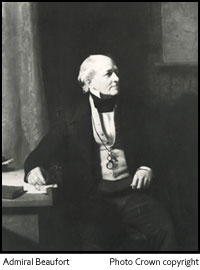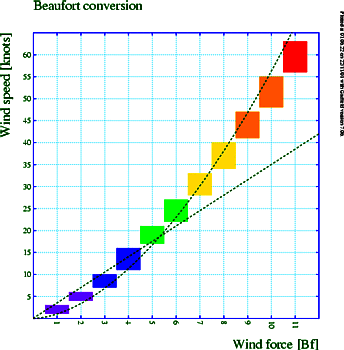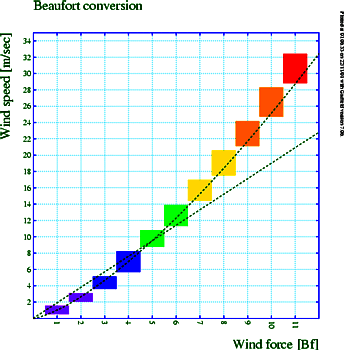 The Beaufort scale
The Beaufort scale
 The Beaufort scale
The Beaufort scale

Sir Francis Beaufort |
The Beaufort scale as originally drawn up made no reference to the speed of the wind, and various attempts, particularly during the 20th century, have been made to correlate the two. An attempt made in 1912 by the International Commission for Weather Telegraphers was interrupted by World War I. In 1921 G.C. Simpson was asked to formulate equivalents, which were accepted in 1926 by the Committee. In June 1939 the International Meteorological Committee adopted a table of values referring to an anemometer at a height of 6 metres (20 feet). This was not immediately adopted by the official weather services of the United States and Great Britain, which used the earlier scale referring to an anemometer at an elevation of 11 metres (36 feet). The Beaufort force numbers 13 to 17 were added by the U.S. Weather Bureau in 1955.
The scale is now rarely used by professional meteorologists, having been largely replaced by more objective methods of determining wind speeds.
| Beaufort number | name of number | wind speed (knots, km/h, m/sec) | description of sea surface | sea disturbance | average wave height |
|---|---|---|---|---|---|
| 0 | calm | < 1 knots, < 0.5 m/sec | sea like a mirror | 0 | - |
| 1 | light air | 1-3 knots, 0.5-1.5 m/sec | ripples with appearance of scales are formed, without foam crests | 0 | - |
| 2 | light breeze | 4-6 knots, 2.1-3.1 m/sec | small wavelets still short but more pronounced; crests have a glassy appearance but do not break | 1 | 0-20 cm |
| 3 | gentle breeze | 7-10 knots, 3.6-5.1 m/sec | large wavelets; crests begin to break; foam of glassy appearance; perhaps scattered white horses | 2 | 30-60 cm |
| 4 | moderate breeze | 11-16 knots, 5.7-8.2 m/sec | small waves becoming longer; fairly frequent white horses | 3 | 1 m |
| 5 | fresh breeze | 17-21 knots, 8.7-11 m/sec | moderate waves taking a more pronounced long form; many white horses are formed; chance of some spray | 4 | 1.8 m |
| 6 | strong breeze | 22-27 knots, 11-14 m/sec | large waves begin to form; the white foam crests are more extensive everywhere; probably some spray | 5 | 3 m |
| 7 | moderate gale (or near gale) | 28-33 knots, 14-17 m/sec | sea heaps up and white foam from breaking waves begins to be blown in streaks along the direction of the wind; spindrift begins to be seen | 6 | 4 m |
| 8 | fresh gale (or gale) | 34-40 knots, 17-21 m/sec | moderately high waves of greater length; edges of crests break into spindrift; foam is blown in well-marked streaks along the direction of the wind | 6 | 5.5 m |
| 9 | strong gale | 41-47 knots, 21-24 m/sec | high waves; dense streaks of foam along the direction of the wind; sea begins to roll; spray affects visibility | 6 | 7 m |
| 10 | whole gale (or storm) | 48-55 knots, 25-28 m/sec | very high waves with long overhanging crests; resulting foam in great patches is blown in dense white streaks along the direction of the wind; on the whole the surface of the sea takes on a white appearance; rolling of the sea becomes heavy; visibility affected | 7 | 9 m |
| 11 | storm (or violent storm) | 56-63 knots, 29-32 m/sec | exceptionally high waves; small- and medium-sized ships might be for a long time lost to view behind the waves; sea is covered with long white patches of foam; everywhere the edges of the wave crests are blown into foam; visibility affected | 8 | 11 m |
| 12-17 | hurricane | 64 knots, 33 m/sec and above | the air is filled with foam and spray; sea is completely white with driving spray; visibility very seriously affected | 9 | 14 m and more |
Conversions computed taking 1852 m per nautical mile. The Beaufort scale does not bear a simple relation to wind speed, as shown by the conversion graphs below. The conversion does not even have a monotonously increasing step size. A power law (with power 1.75 for knots and 1.4 for m/sec, curved dashed lines) provides a valid approximation for the m/sec scale, but this is hardly practical. Linear approximations (straight dashed lines) do not fit more than 2-3 steps of the scale.
 |
 |
(Figures in PS format.)